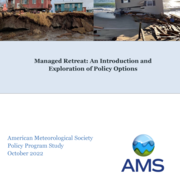Executive Summary
The human relationship with nature can be difficult to parse, especially when hazardous environmental conditions threaten our way of living. As sea levels rise, 100-year floods occur more frequently than ever, and permafrost melts at unprecedented rates, these phenomena (and others) inflict change in our environment that may necessitate a reaction. Deciding on how to react and ensuring those steps are taken is a large part of the weather, water, and climate community’s work from weather forecasting to emergency response. Sometimes the hazards and threats that communities face from weather or climate-related events are repeated and, on some level, forecastable. Researchers have projections for the rates of sea level rise along the coasts and for seasonal drought outlooks, tools that can inform the process of decision-making. Taking proactive steps instead of only reactionary actions to these threats can be a live-saving approach.
Proactive measures against environmental threats can take many forms including protection, accommodation, and relocation. In some cases, protective and accommodating actions such as building sea walls and elevating structures respectively can be sufficient for the protection of life and property. However, not all communities experience the same degrees of exposure, hazard, vulnerability, or resilience—some communities may be at greater risk for hazards that cannot be accommodated for or be protected from.
Managed retreat is a tool for community adaptation to repeated environmental threats that involves the physical relocation of people, structures, and infrastructures away from areas exposed to repeat hazards. Though conversations surrounding managed retreat are becoming more commonplace in academic literature and public policy vernacular, the practice has been around for decades, as explained in the case studies at the end of this document.
Managed retreat is not particularly a popular choice: much of our human experience is tied to the place where we live, our neighbors, shared location-based history and culture, and a sense of belonging. Asking people to physically move away from their home or homeland is an idea often met with resistance. For this reason, we approach managed retreat as a tool for decision-making. Keeping conversations open to managed retreat, not necessarily as an end goal but as an avenue to explore, may help communities find creative solutions to their concerns or better understand what barriers to adaptation efforts exist in their neighborhoods.
The list of stakeholders that are involved in discussing or enacting managed retreat extend far beyond the weather, water, and climate (WWC) community of which the American Meteorological Society (AMS) is part. However, there are opportunities for those involved in the WWC enterprise to inform, enable, and support fellow stakeholders in these conversations and decisions. From research to public communications to community engagement, the WWC community, including key federal, academic, NGO, and private institutions, can be a supporting partner.
The AMS Policy Program conducted literature reviews, attended conferences with managed retreat as the focus, and conducted interviews with experts in the field to gather, organize, and synthesize relevant and up-to-date information on managed retreat. There exist four main goals for this document: 1) to provide relevant, useful, introductory information to demystify retreat for decision-makers; 2) to encourage and enable conversations around this adaptive strategy; 3) to promote a framework of continual education and emphasize that progress on managed retreat is grounded in iterative processes instead of a one-time activity; and 4) to provide a range of potential actionable next steps tailored to community and local audiences. If society is broadly unprepared and unwilling to have these conversations, the option of retreat as a climate adaptation will be overlooked despite its potential merits and without addressing the roots of its inadequacies. This study explores the intricacies of managed retreat and to enable the individuals and local communities to consider whether, when, and how managed retreat can meaningfully address climate change vulnerabilities.
In this study, we introduce and explore managed retreat as an adaptive strategy to climate hazards with the goal of identifying the policy options for enacting managed retreat and exploring these policies’ strengths and limitations. We seek to provide the context and information that can enable deliberations but stops short of including value judgements and being prescriptive, leaving stakeholders to decide the best course of action for their own nuanced situation. This study will include background information regarding risk assessment, strategies for resilience, and the terminology behind “managed retreat” to describe why this adaptive strategy is being discussed. We will identify key stakeholders in the discussions surrounding managed retreat and the role that they may be able to play. Though AMS is part of the WWC community, the issue of managed retreat and community adaptation in general extends far beyond the reaches of this community. The identification of stakeholders outside the WWC community is not an attempt to punt the responsibility of creating solutions off to another sector, but rather to identify areas of need and opportunities to provide external support and highlight the inherent interdisciplinary nature of this issue. We will also outline best practices for exploring managed retreat that include but are not limited to 1) champion community led efforts, 2) listen, 3) operate with voluntary participation, and 4) frame the process with human rights in the forefront of decision-making. We will explore eight case studies illustrating how different policies can shape how managed retreat is done. To round off the document, we will identify key funding opportunities to enable decision makers to find resources for further assessment or action, with a particular emphasis on federal programs FEMA and HUD.
Suggested Citation:
White, L. 2022: Managed Retreat: An Introduction and Exploration of Policy Options. An AMS Policy Program Study. The American Meteorological Society, Washington, D.C. https://doi.org/10.1175/managed-retreat-2022
